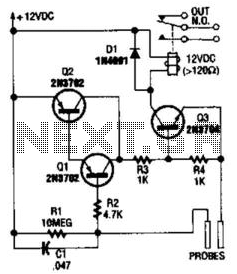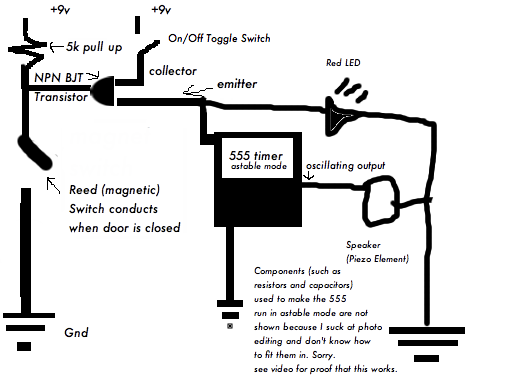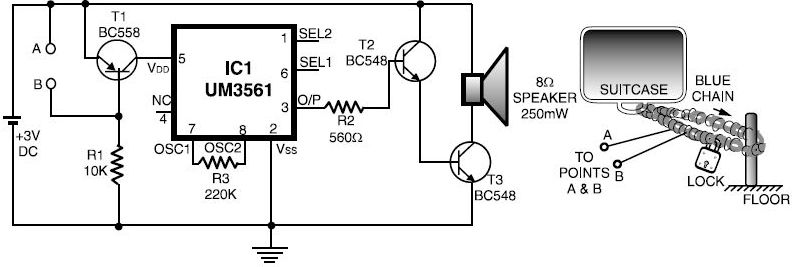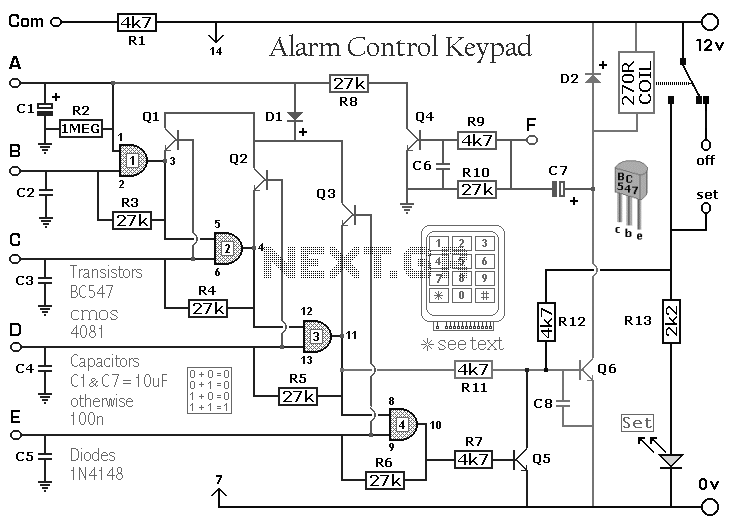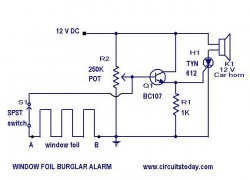
modular burglar alarm
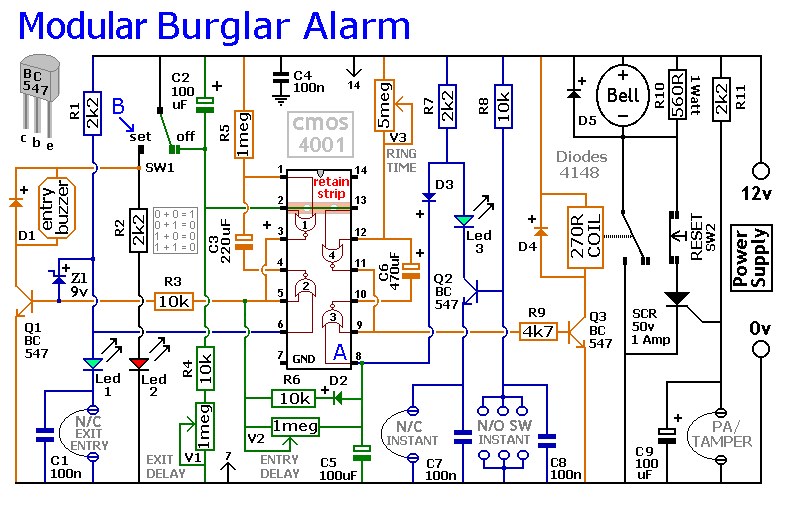
This circuit incorporates automatic exit and entry delays along with a timed bell cut-off feature. It accommodates both normally-closed and normally-open contacts and includes a 24-hour personal attack/tamper zone. The circuit is permanently connected to a 12-volt supply and is activated by opening switch SW1. Expansion modules can be added to include additional zones, which may consist of inertia (shock) sensor types. All green LEDs should illuminate prior to opening SW1, allowing approximately one minute for exit from the building. During this exit, a buzzer will sound, ceasing once the door is closed, indicating that the exit/entry loop has been successfully restored within the allotted time. Upon re-entry, there is a one-minute window to turn SW1 off; failure to do so will energize the relay, sounding the main bell for up to 40 minutes, although it can be silenced at any time using SW1. The "Instant" zone operates without an entry delay. If normally-open switches are not desired, resistors R8, capacitor C8, and transistor Q2 can be omitted, with a link installed between LED 3 and capacitor C7. The 24-hour personal attack/tamper protection is managed by an SCR/thryristor; opening any switch in the normally-closed loop will trigger R11, activating the SCR and ringing the bell without a time limit. The bell can be reset by pressing switch SW2 to temporarily interrupt current flow once the loop is closed again. While the basic circuit is adequate for many applications, dividing the alarm into zones simplifies fault detection, with the control panel indicating which zone activated the alarm. Expansion modules are designed for this purpose, intended to replace the existing instant zone. When a zone is activated, its corresponding red LED will illuminate and remain lit until the reset button is pressed. All modules can utilize a single reset button.
This electronic schematic is designed for security applications, providing comprehensive monitoring and alarm functionalities. The circuit's architecture allows for both flexibility and scalability through the use of expansion modules, which can be integrated to accommodate various sensor types and configurations. The 12-volt power supply ensures compatibility with a wide range of electronic components, while the use of both normally-closed and normally-open contacts offers versatility in installation options.
The automatic exit and entry delays are critical for user convenience, allowing individuals to exit or enter without triggering the alarm inadvertently. The integration of a timed bell cut-off helps mitigate false alarms, particularly in scenarios where users may take longer than expected to exit or enter the premises. The buzzer serves as an audible cue during the exit phase, enhancing user awareness of the system's status.
The 24-hour personal attack/tamper zone adds an additional layer of security, ensuring that any unauthorized access attempts are promptly detected. The SCR/thryristor mechanism provides a reliable means of triggering the alarm without time constraints, ensuring immediate response to tampering incidents.
The modular design facilitates easy upgrades and maintenance, allowing users to expand their security system as needed. The inclusion of visual indicators, such as green and red LEDs, aids in system diagnostics, enabling users to quickly ascertain the operational status of each zone. The single reset button feature streamlines the process of resetting the alarm system, enhancing user experience.
Overall, this circuit represents a robust solution for security applications, combining ease of use with advanced features to provide effective monitoring and alarm capabilities.This circuit features automatic Exit and Entry delays and a timed Bell Cut-off. It has provision for both normally-closed and normally-open contacts, and a 24-hour Personal Attack/Tamper zone. It is connected permanently to the 12-volt supply and its operation is "enabled" by opening SW1. By using the expansion modules, you can add as many zones as you require; some or all of which may be the inertia (shock) sensor type. All the green LEDs should be lighting before you open SW1. You then have up to about a minute to leave the building. As you do so, the Buzzer will sound. It should stop sounding when you shut the door behind you. This indicates that the Exit/Entry loop has been successfully restored within the time allowed. When you re-enter the building you have up to about a minute to move SW1 to the off position. If SW1 is not switched off in time, the relay will energise and sound the main bell. It will ring for up to about 40 minutes. But it can be turned off at any time by SW1. The "Instant" zone has no Entry Delay. If you don`t want to use N/O switches, leave out R8, C8 and Q2; and fit a link between Led 3 and C7. The 24 Hour PA/Tamper protection is provided by the SCR/Thyristor. If any of the switches in the N/C loop is opened, R11 will trigger the SCR and the bell will ring. In this case the bell has no time limit. Once the loop is closed again, the SCR may be reset by pressing SW2 and temporarily interrupting the current flow. The basic circuit will be satisfactory in many situations. However, it`s much easier to find a fault when the alarm is divided into zones and the control panel can remember which zone has caused the activation.
The expansion modules are designed to do this. Although they will work with the existing instant zone, they are intended to replace it. When a zone is activated, its red LED will light and remain lit until the reset button is pressed. All the modules can share a single reset button. 🔗 External reference
This electronic schematic is designed for security applications, providing comprehensive monitoring and alarm functionalities. The circuit's architecture allows for both flexibility and scalability through the use of expansion modules, which can be integrated to accommodate various sensor types and configurations. The 12-volt power supply ensures compatibility with a wide range of electronic components, while the use of both normally-closed and normally-open contacts offers versatility in installation options.
The automatic exit and entry delays are critical for user convenience, allowing individuals to exit or enter without triggering the alarm inadvertently. The integration of a timed bell cut-off helps mitigate false alarms, particularly in scenarios where users may take longer than expected to exit or enter the premises. The buzzer serves as an audible cue during the exit phase, enhancing user awareness of the system's status.
The 24-hour personal attack/tamper zone adds an additional layer of security, ensuring that any unauthorized access attempts are promptly detected. The SCR/thryristor mechanism provides a reliable means of triggering the alarm without time constraints, ensuring immediate response to tampering incidents.
The modular design facilitates easy upgrades and maintenance, allowing users to expand their security system as needed. The inclusion of visual indicators, such as green and red LEDs, aids in system diagnostics, enabling users to quickly ascertain the operational status of each zone. The single reset button feature streamlines the process of resetting the alarm system, enhancing user experience.
Overall, this circuit represents a robust solution for security applications, combining ease of use with advanced features to provide effective monitoring and alarm capabilities.This circuit features automatic Exit and Entry delays and a timed Bell Cut-off. It has provision for both normally-closed and normally-open contacts, and a 24-hour Personal Attack/Tamper zone. It is connected permanently to the 12-volt supply and its operation is "enabled" by opening SW1. By using the expansion modules, you can add as many zones as you require; some or all of which may be the inertia (shock) sensor type. All the green LEDs should be lighting before you open SW1. You then have up to about a minute to leave the building. As you do so, the Buzzer will sound. It should stop sounding when you shut the door behind you. This indicates that the Exit/Entry loop has been successfully restored within the time allowed. When you re-enter the building you have up to about a minute to move SW1 to the off position. If SW1 is not switched off in time, the relay will energise and sound the main bell. It will ring for up to about 40 minutes. But it can be turned off at any time by SW1. The "Instant" zone has no Entry Delay. If you don`t want to use N/O switches, leave out R8, C8 and Q2; and fit a link between Led 3 and C7. The 24 Hour PA/Tamper protection is provided by the SCR/Thyristor. If any of the switches in the N/C loop is opened, R11 will trigger the SCR and the bell will ring. In this case the bell has no time limit. Once the loop is closed again, the SCR may be reset by pressing SW2 and temporarily interrupting the current flow. The basic circuit will be satisfactory in many situations. However, it`s much easier to find a fault when the alarm is divided into zones and the control panel can remember which zone has caused the activation.
The expansion modules are designed to do this. Although they will work with the existing instant zone, they are intended to replace it. When a zone is activated, its red LED will light and remain lit until the reset button is pressed. All the modules can share a single reset button. 🔗 External reference
